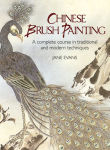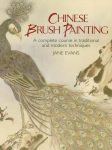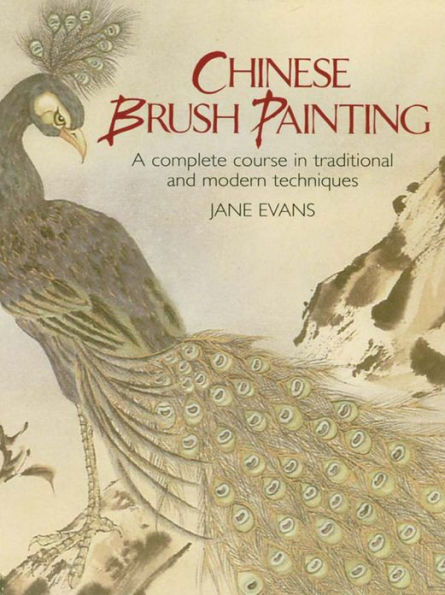
Chinese Brush Painting: A Complete Course in Traditional and Modern Techniques
144
Chinese Brush Painting: A Complete Course in Traditional and Modern Techniques
144eBook
Available on Compatible NOOK devices, the free NOOK App and in My Digital Library.
Related collections and offers
Overview

Product Details
| ISBN-13: | 9780486136837 |
|---|---|
| Publisher: | Dover Publications |
| Publication date: | 07/05/2012 |
| Series: | Dover Art Instruction |
| Sold by: | Barnes & Noble |
| Format: | eBook |
| Pages: | 144 |
| File size: | 35 MB |
| Note: | This product may take a few minutes to download. |
About the Author
Read an Excerpt
Chinese Brush Painting
A complete course in traditional and modern techniques
By Jane Evans
Dover Publications, Inc.
Copyright © 1987 Jane EvansAll rights reserved.
ISBN: 978-0-486-13683-7
CHAPTER 1
THE APPEAL OF CHINESE BRUSH PAINTING
In the West we tend to expect painters to be flamboyant, excitable, untidy and often amoral! The Chinese painter, by contrast, is contemplative and serene, steeped in the philosophical and ethical preoccupations of his society. Perhaps this is because Chinese brush painting provides its practitioners with more than just technical skills. To learn brush painting, the would-be artist should strive not only to master the techniques but also to understand something of the philosophy and aesthetics involved. Its appeal is partly like that of other Eastern imports such as yoga and kung fu, for it seems to provide a soothing influence brought about by mastering a traditional skill through a time-honoured, ritualized learning process. Japanese Sumi, or brush and ink, painting has been described as a 'meditation in ink' and this is equally applicable to Chinese painting. It scores over meditation, however, in that it can convey its calming effect to the spectator as well as to the performer. The artist also has the satisfaction of following a well-marked path to deeper understanding, with clear stages of achievement along the way.
This is not to say that Chinese painting has little to offer in the technical line. Chinese painting materials are very versatile, far more so than their nearest Western equivalents. Chinese ink is capable of an endless variety of shades and depths of black and grey. The colour pigments combine the best properties of watercolour and those of tempera, having the translucency of the former and the fixity of the latter. The brushes, too, are almost infinitely adaptable. A good wolf-hair brush can hold considerably more paint or ink than its Western counterpart. This allows you to load it with up to three tones or colours at once so that, for example, you can complete a plant in one go without having to go back to your palette for more colour. This helps to achieve spontaneity and unity. Regardless of its size, a good brush will enable you to draw a fine line and, if spread appropriately, will give you a number of 'split-brush' and 'feather' strokes which a Western sable brush would resist. Horse-hair and goat-hair brushes create special effects of which no Western brush is capable. Chinese paper comes in several qualities, some more absorbent than others. Even the least absorbent feels like blotting paper to artists accustomed to watercolour paper, but once control of the absorbency is mastered, there is a multitude of effects to be achieved with the different kinds of paper.
Westerners are sometimes put off by the thought of the effort needed to master the disciplined technique demanded by Chinese painting. In fact, you will not find yourself becoming impatient because you will progress steadily from one subject to another. For example, you master plum blossom before you move on to bamboo, and you must master bamboo before you move on to orchids. Thus your progress is punctuated by the acquisition of specific skills and the production of pleasing pictures. Over a period of time you will find you have imperceptibly built up a store of technical knowledge that will enable you to tackle any subject. Far more than with any other painting technique, such as oil or watercolour, you will enjoy a sense of development and progress as you study. This feeling will never leave you, however long you brush paint.
The Western student brought up to believe in the importance of 'freedom of expression' sometimes worries that the emphasis on correct technique will lead to loss of artistic originality. This is felt particularly in the case of Chinese painting because it is traditionally learnt by carefully copying the works of established artists. Indeed, the problem has not gone unnoticed by the Chinese themselves: as long ago as the seventeenth century Chieh Tzu Yüan Hua Chuan in The Mustard Seed Garden Manual of Painting (1679-1701) stated, 'If you aim to dispense with method, learn method. If you aim at facility, work hard. If you aim for simplicity, master complexity.' Just as a good driver does not think about changing gear, it is only when you have fully mastered the control of ink, brush and paper so that it has become almost subconscious, that you will be released from worry about your technical performance and be able to express yourself fully
Even in the West it is only in recent years that method and technique have become suspect elements in the pursuit of good art: in the past painters studied hard under masters and copied their works assiduously. Today it is in fact mainly in the visual arts that we worry that originality may be smothered by technique. No-one suggests that ballet dancers should not learn the individual steps - it is how they are performed and put together that determines the merit of the performance. Brush strokes are the dance steps of painting and composition its choreography.
Learning by copying is especially useful for people not brought up in the East. Not only do Chinese art students have the advantage of having been taught to write using brush, ink, paper, and even many of the brush strokes, they have also been brought up with Chinese paintings and have absorbed a feeling for composition and colour in the same way that we in the West have become familiar with Leonardo, Renoir and Picasso. By copying from Chinese paintings, Western students can not only better appreciate the techniques and brush strokes used, but also begin to develop a feeling for composition and colour which will stand them in good stead when they produce their own 'original' works.
This does not mean that this method of learning has no drawbacks: indeed, the history of Chinese painting bears witness to these. There has been an inevitable tendency towards stylization and loss of freshness, and it is fair to say that in the past there have been fewer innovative painters in China than in the West. However, this is no longer the case. One of the beneficial effects of the impact of Western ideas and attitudes and of social and political upheaval has been a great burst of originality and innovativeness in Chinese painting.
Innovation does require effort, however. Provided you are aware of this and use the painted model as a general guide to brush strokes, colour and composition, rather than as a copybook to be slavishly imitated, the danger of simply learning how to copy rather than to create is not too great. Moreover, it can be totally overcome by your striving to become more observant of the things around you. Even though it is not used as a direct model, in the sense that Chinese artists do not traditionally sit in front of the objects they paint, you should be particularly aware of your environment. Watch birds: see how they are structured; how they land and take off; how they sit and stand; how they fluff up their feathers in winter. You should notice flowers, leaves, trees and rocks; observe colours and shapes; and discover how things work.
There are plenty of precedents for Westerners in Chinese painting. In the seventeenth century several Jesuit priests went to China to convert the people to Catholicism. Some of them stayed to become court painters. The best known of these was Giuseppe Castiglione, court painter to Emperor Chien Lung. His Chinese name was Lang Shih Ning. Later, the Irish painter Chinnery was very influenced by Chinese painting and by his stay in China, and Van Gogh did a series of paintings trying to imitate the Japanese style. In the twentieth century several Chinese painters have started to look towards the West and a number of the more innovative ones have studied abroad and adopted Western ideas on perspective and light.
The Western student will, however, never become Chinese, and should not try to. Hopefully you will achieve a blend of East and West. You will learn an idiom and a technique and come to grips with a philosophy and outlook. My own teacher, Chen Bing Sun, liked to have an occasional European in his class. He believed that the union of China and Europe produced something very interesting from the point of view of painting. Therefore, while it is of course very important that you should absorb the principles of Chinese aesthetics as you learn to paint in the Chinese style, do not forget that you are a Westerner. I hope by the end of this book you will have learnt enough to feel free to 'do your own thing'. In other words, keep using your own aesthetic judgement and compositional skills, and combine them with your new techniques. Remember that the word Chinese in 'Chinese brush painting' refers to the brush, not to the artist.
As a final observation to help the Western student who is interested in taking up Chinese brush painting, it is perhaps worth remarking that Chinese painting lacks the self-conscious earnestness that frequently mars Western art. One of the most refreshing elements of Eastern art is its abundance of humour, as the painting below illustrates. This is not to say that Chinese painters do not take their work seriously, but they retain their ability to look at the world with a certain detached irony.
CHAPTER 2PAINTING IN CHINESE CULTURE
It is important to be able to put what you are learning into its appropriate cultural perspective. If you know, for example, a little about the philosophical foundations of Chinese painting you will find it easier to appreciate what qualities you should strive for and why. This book is intended to provide a practical course of instruction for the would-be brush painter: it is not an account of the history and philosophy of Chinese painting. However, this chapter attempts to sketch in some essential background while making no pretence at being a definitive guide. There are many excellent books available on these topics and the bibliography at the end of this book contains details of a few of them.
Unlike Europe, China can claim a continuous cultural heritage going back to before 2000 BC. The Chinese have displayed a remarkable talent for making invaders conform to Chinese cultural norms, in contrast to Europe where it was generally the invaded who succumbed to the mores, language and institutions of the invaders. With the possible exception of the Mongols, whom they expelled after a comparatively short period, the Chinese have succeeded in sinofying their foreign overlords, who usually made use of Chinese institutions and adopted Chinese cultural values. In fact, the invaders often became enthusiastic upholders and promoters of Chinese traditions, especially in the fields of art and literature.
It is now thought that the Chinese had been using brushes for painting and writing long before the dawn of recorded Chinese history. Neolithic pottery shows clear evidence of brushwork designs, though the patterns are simple. From the sixteenth to the tenth centuries BC during the Shang dynasty, ideograms began to appear and evolve, though they were probably invented even earlier. There were certainly wall paintings in existence during the Zhou dynasty (c. 1000-200 BC) and evidence of fully fledged brushwork is abundant from the Han dynasty (c. 200 BC-AD 200) onwards. Paper manufacture began during the first century AD and before that there were surely silk and tomb paintings.
The history of painting in China is thus a very long one. It is also very complex. There is a tendency in the West to think of Chinese painting as a homogeneous topic rather like Impressionism or Italian Renaissance painting. In fact, of course, a comparable field of study would be the entire range of European painting from the Greeks and Romans to the present day, taking in all the periods of Spanish, French, Italian, German, Dutch and English painting along the way. At any one time in China there were as many different styles of painting being produced as there were in the whole of Europe.
It is nevertheless possible to trace two broad themes or movements in Chinese painting. These are often referred to as the Academic and the Literary schools, though I personally believe that 'school' is a misleading term in this context. In Europe it is normally applied to a group of painters such as the Pre-Raphaelites. China, too, has had movements and schools of painters in this European sense, but in addition to this all Chinese painting has tended to conform to one or other of the two major traditions, which have transcended and outlived the schools. These traditions can still be found in modern painting. You will be shown how to paint in both these ways in the later part of this book.
During the Han dynasty most painters were probably humble artisans working anonymously for a feudal lord and regarded as fairly low down on the social scale. However, it seems that a different class of Academic painters who enjoyed a much higher social status began to emerge towards the end of the Han, and the tradition of Academic painting, or Huan Hua Pai, has continued almost uninterrupted until the present. It has been the style of court painters throughout the dynasties, has varied little through the ages, and has its modern proponents today. Described as gongbi hua, which can be translated as 'fine style painting', it is painstaking and detailed, requiring a clean line and skilful colour blending. The colour is added as tinting and does not usually form a key element or contribute to the expression of the painting. Every brush stroke is precise. Pictures done in this style tend to be formal and elaborate, and take time to produce.
The other main tradition in Chinese painting is the Literary school, or Wen Jen Hua Pai. Most of today's painters in China and outside it can probably best be seen as descendants of this school. It is characterized by the xieyi hua, which can roughly be translated as 'to write an idea'. It was undoubtedly developed to liberate artists from gongbi and its aim is to depict as much as possible in the smallest number of bold strokes. Its style is simplified and free - vital expression is more important than the mere rendering of form. Xieyi is much more difficult to master than gongbi. A xieyi painting should be completed 'in one breath'; in other words, it should be done in one sitting so that the life force is not broken. The term used to describe this rhythmic vitality or harmony with the ITLχITL is chi yuen. As all natural things have an inner spirit, the ITLχITL, they also have yuen, which is the flowing vitality that expresses the ITLχITL.
A xieyi painting should be lively, the brush strokes bold and firm. It should show rhythm and fluidity. A xieyi painting must not be merely technically accomplished, however. It can be a compliment to a painting to describe it as chuo, or awkward, because this distinguishes it from chiao, which means dextrous and clever but lacking in feeling. Xieyi paintings should be spontaneous and exciting to look at. A painting should represent the artist's distillation and comprehension of reality rather than be simply an actual representation of it. It should embody his perception of the underlying true nature of his subject.
Most of the innovative influences in Chinese painting have come from the Literary school; even today painters are able to absorb Western ideas and techniques and yet produce works of art that are surely part of an unbroken tradition of expressive Chinese painting stretching back at least as far as the critic Hsieh Ho in the fifth century.
(Continues...)
Excerpted from Chinese Brush Painting by Jane Evans. Copyright © 1987 Jane Evans. Excerpted by permission of Dover Publications, Inc..
All rights reserved. No part of this excerpt may be reproduced or reprinted without permission in writing from the publisher.
Excerpts are provided by Dial-A-Book Inc. solely for the personal use of visitors to this web site.
Table of Contents
Contents
DOVER BOOKS ON ART INSTRUCTION,Title Page,
Copyright Page,
Note,
Errata,
Acknowledgements,
Note on the spelling of Chinese words and names,
Preface,
THE APPEAL OF CHINESE BRUSH PAINTING,
PAINTING IN CHINESE CULTURE,
EQUIPMENT,
MAKING A START,
PAINTING PLUM OR JADE BLOSSOM,
PAINTING BAMBOO,
PAINTING ORCHIDS,
PAINTING CHRYSANTHEMUMS,
PAINTING ROCKS,
PAINTING PINE,
PAINTING GRASSES,
PAINTING PEONY,
PAINTING LOTUS,
PAINTING INSECTS,
PAINTING FISH AND OTHER AQUATIC CREATURES,
PAINTING BIRDS,
PAINTING MAMMALS,
PAINTING PEOPLE,
PAINTING LANDSCAPES,
APPLYING WASHES,
MORE ADVENTUROUS TECHNIQUES,
MOUNTING AND PRESENTATION,
IN CONCLUSION,
WHERE TO SHOP,
BIBLIOGRAPHY,



